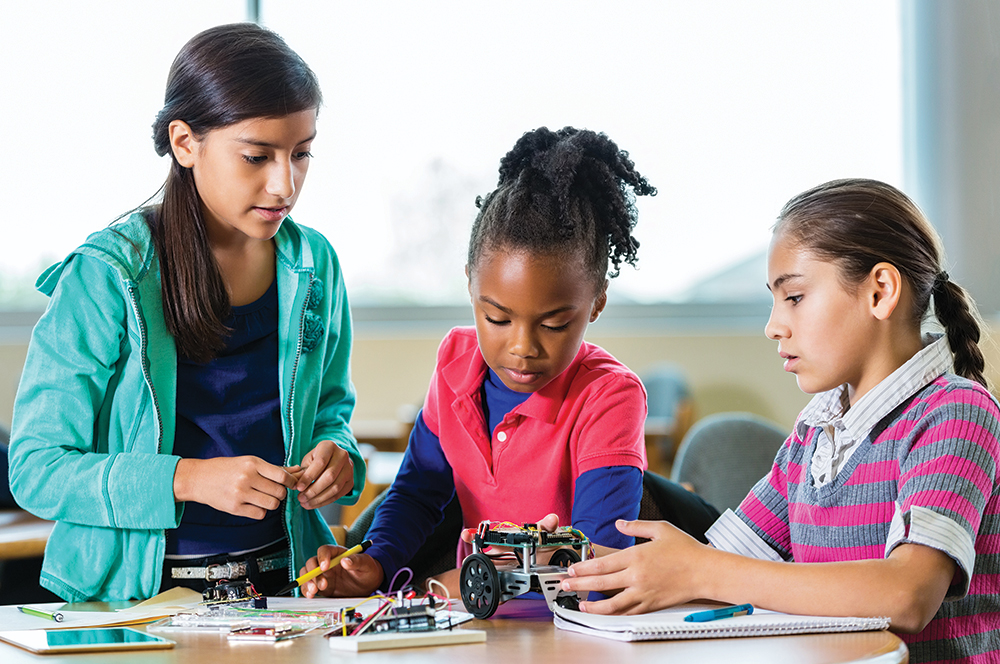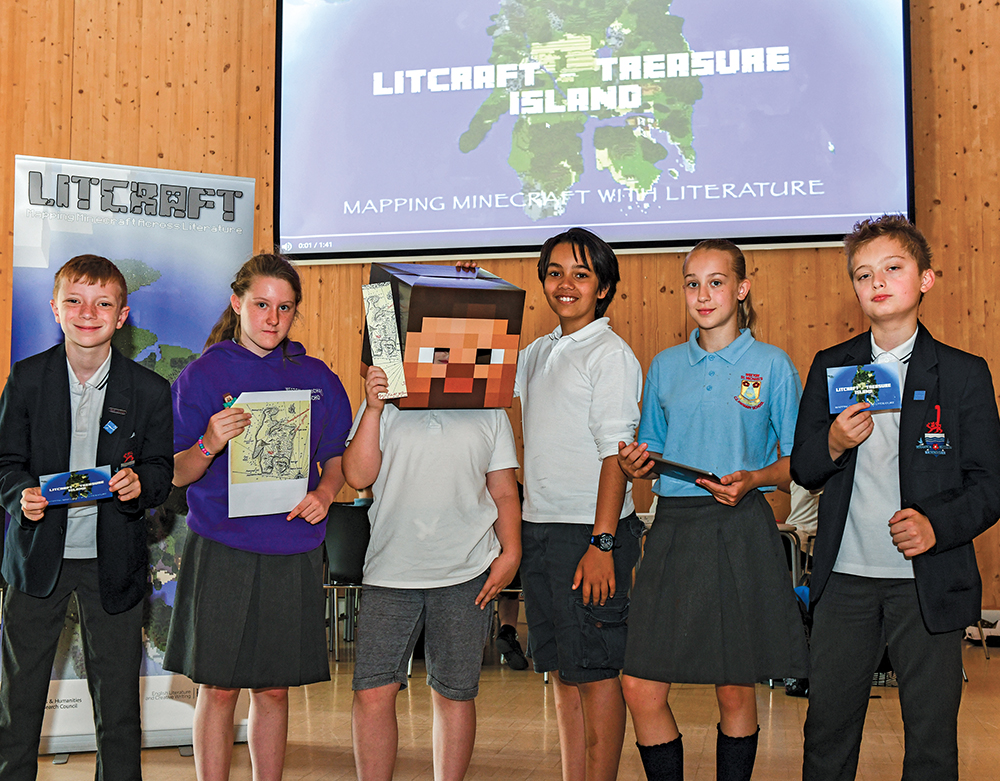Tweens and Tech: Engaging Kids With Litcraft, Digital Dancing, and Gamification
Using technology to forge literary and artistic connections with today's preteens.
 |
Steve Debenport/Getty Images |
When the public library in Hudson, NY, moved from a century-old almshouse into a newly renovated armory a block away in 2016, it became the place to go. Locals who had never visited the library before started hanging out there—including middle schoolers, who made themselves comfortable in common area chairs during the late afternoon.
Shanekia McIntosh saw an opportunity. A writer and curator of art exhibitions around Hudson, McIntosh thought the Hudson Area Library’s (HAL) armory space was a perfect place to bring together tween-agers and local artists. In the summer of 2016, HAL held its first Hack the Library program—a weekend of free labs where kids learned from experts how to use digital technology to create works in sound, video, and images. McIntosh was hired as the full-time youth programmer, and Hack the Library has since grown into a twice-a-year event.
While many librarians who started in adult or children’s services are directing more attention toward tweens, those like McIntosh who are comfortable with the latest digital tech are especially well suited for a generation raised on iPads and smartphones. They’re using technology to spark kids’ interest in the arts, literacy, and more. At libraries, tweens can experiment with tech without the pressure of grades and still develop important habits of collaboration and discovery—all while having fun.
McIntosh regularly meets with a tween council, eight kids between the ages of eight and 12. What they want, McIntosh says, are opportunities to try out various art mediums in a “judgment-free” zone, where they aren’t made to feel awkward if they don’t understand. Recent immigrants—Yemeni, Salvadoran, Bangladeshi—are among the group, and not all have smart devices at home.
“The library is the only space in town where you get a diverse group of people all in one place,” McIntosh says. “Communities that you wouldn’t see at other programs come to the library because they feel safe here.”
 Looking for something cool
Looking for something cool
“There’s no real developmental stage that encapsulates what we describe as a tween,” says Amy Pattee, associate professor of school and library information science at Simmons College. “Most contemporary writing and research has talked about tweens as a marketing category that emerged because of the growing size of that population and consequently their buying power.”
Our perception of tweens is partly informed by publishing trends, Pattee adds. “There’s been something of a boom in middle grade publishing,” she says. “There’s new recognition, inspired by the popularity of series like ‘Harry Potter,’ ‘Percy Jackson,’ and ‘Wimpy Kid,’ all drawing attention to the interests and reading habits of young people.”
Still, defining tween interests is an ongoing challenge. “They want something cool—and I’m not sure I can always define what that is,” says Addie Matteson, middle school librarian at Westminster, an independent school in Atlanta. “They’re looking for something they have never seen before.”
Matteson teaches coding to eighth graders, and their current project is to make a wearable technology using a micro:bit, a tiny computer with an LED array than can be programmed to flash letters one at a time, like an LED scrolling sign. The micro:bit also contains a gyroscope and temperature sensor. The students use JavaScript to program the device on laptops, where they can see what the micro:bit’s light array looks like as text. The task is to turn the micro:bit into a wearable device that isn’t tethered to a computer and that can solve a problem.
One team wants to program the micro:bit to spell out a word tapped into it by Morse code. “I don’t think they know how ambitious that is, but I’m going to let them just go,” Matteson says.
The point is to work toward solving the problem more than to actually solve it. “A lot of the culture of the coding class is to figure it out, which can be frustrating,” says Matteson. “I kind of want them to live with the frustration, because a part of it is just [developing] the grit to get through not knowing how something works and figuring it out. Programming gives them that space and that freedom to fail.”
Matteson sees her students daily and has the time to help them through the entire process, from design and prototypes to printing out wristbands and plastic casing on a 3-D printer. A shorter version of the class could be done in a public library program, she says. “You could make something wearable with micro:bits in about three hours. You’d have to move fast. Or maybe in a few days, as part of a single program. It would have to be scaled down for different skill levels.”
“I am always looking for a way students can use tech to create something new,” she adds. “Anything that allows them to create and not just consume is always a better educational tool. When they make something, they are engaged, especially if it’s challenging, and they have something to be proud of.”
For curious minds, art-infused tech
Community-oriented programs like McIntosh’s can be vital for tweens seeking emotional connections and an outlet for this age group’s curiosity and desire for self-expression. Still, “It’s a funny time,” says McIntosh. “They’re going through puberty. Their voices are changing and they’re getting taller. I’m just happy to retain their interest.”
Sometimes, McIntosh recruits artists she knows for her programs, such as a local painter, filmmaker, or fashion designer. The library also engages nonprofits, including the Deep Listening Institute, in Kingston, NY, or Brooklyn-based Sonic Arts for All. The kids have dubbed the events DIBS, the “Do It Better Series.”
Students have made sound collages by recording noises around the library on smartphones—shuffling feet, creaking doors—and editing these bits together into a seamless whole. They’ve made short films with local videographers Theo Anthony and Zia Anger that started with research in the library’s history room and walks about Hudson, and culminated in short, idiosyncratic films, from historical reenactments to science fiction dramas.
A September program, Digital Dancing, combined dance and augmented reality. Over three days, tweens rehearsed with choreographer Adam Weinert to create a performance that was shot from multiple angles—by kids—on smartphones. Later, library visitors could use their phones to scan a QR code at various spots where the dance took place and relive the performance.
While the programs range widely, they’re all replicable, says McIntosh. All make use of free or inexpensive tech—library-owned smartphones and open software: Audacity for recording and editing sound, and DaVinci and iMovie (not open, but readily available) for video. The idea is that the kids can continue to use the skills they acquire. The tweens also do their own promotion, making flyers and spreading the word at school.
“We don’t want to do the programs where we have the expensive equipment and say, ‘Look at all this cool stuff—we’re taking it back now,’” McIntosh says. “The whole point is that the kids can keep making stuff on their own time.”
Short, intense programs work the best for tweens, McIntosh adds—and it’s how they want to learn.
 |
Tweens at Lancaster University (UK), where professor Sally Bushell designed the Litcraft game, based on classic novels.Photo courtesy of the University of Lancaster |
Gaming—it’s lit
Sally Bushell, a literature professor at Lancaster University, UK, is betting that tech can spark a love of reading among teens. Bushell is the designer of Litcraft, an immersive game built on the Minecraft platform, in which players use a classic novel as a kind of map for navigating the tale’s virtual world. Students read a section of the novel, then enter the Minecraft-like world where they encounter various tasks, from solving problems raised in the novel’s plot to writing.
The prototype Bushell has tested out with teachers and librarians is based on Robert Louis Stevenson’s Treasure Island. Players assume the role of the protagonist, Jim, hopping ashore on Skeleton Island, discovering treasure chests, and searching for clues, while following the novel’s plot as a guide through the digital landscape. A series of writing tasks gives players an opportunity to reflect on the novel’s meaning much in the way a real Jim might think about his own experience, Bushell says. Litcraft’s target audience is kids 10 to 12, though Bushell wants to a create a version based on Lord of the Flies for high school students.
Librarians have been much more receptive to the game than classroom teachers, Bushell says. “Teachers have got to meet lots of criteria, so it’s more worrying for them if a game distracts the kids,” she says. “Librarians are so advanced in terms of thinking about how to make digital tools and the digital world accessible to kids. They immediately said to us every time we trialed it, ‘I can think of a kid who doesn’t want to read who would love this.’”
Still, Bushell is reluctant to call Litcraft a game. “We’re taking gaming platforms; we’re not making games,” she says. Kids are learning how to visualize a novel’s environment, a basic cognitive skill that could prime the brain for entering more deeply into the imaginary spaces in the book. “The literary,” Bushell says, “is what you can’t visualize.”
“They’ll try anything”
Michele Haiken, who teaches English language arts at Rye (NY) Middle School, has “gamified” her classroom, yet up close her lessons look familiar to any English teacher. “If we’re talking foundational literacy, [meaning] the reading, writing, speaking, listening, and critical thinking,” Haiken says, “that has always been there.”
Her gamification entails mapping out weeks of assignments and activities on traditional game boards or on a gaming platform, such as Classcraft, so that students can complete work at their own pace and through any number of paths, or “quests,” picking up points they can cash in for rewards, from actual food to previewing an upcoming exam.
In effect, students proceed through class units, about a month’s work, the way they would find their way across Skeleton Island in Litcraft, by choosing the order in which to complete assigned tasks. While everyone in the class arrives at the same destination, individual journeys take the shape most conducive to a student’s learning.
“It’s about teaching the basic skills, but also about teaching skills for a digital and a global world,” Haiken says. “We want students to be savvy and critical consumers of information.”
Tweens’ natural curiosity and openness offer a prime time to develop these values. “Kids come to the council meetings and say, ‘I want to make skits or make a movie like we see on YouTube,’” says McIntosh. “Our goal is to flip it and say, ‘All of this is accessible to you. And here is a way of making it.”
They’re ready to assume the power of making over mere consumption. “It’s such a time of exploration,” says McIntosh. “Tweens don’t have this id thing that drives you nuts. They just go with the flow. They’ll try anything.”
 Brian Seto McGrath is an editor of TIME for Kids magazine.
Brian Seto McGrath is an editor of TIME for Kids magazine.
RELATED
The job outlook in 2030: Librarians will be in demand
The job outlook in 2030: Librarians will be in demand
ALREADY A SUBSCRIBER? LOG IN
We are currently offering this content for free. Sign up now to activate your personal profile, where you can save articles for future viewing






Add Comment :-
Comment Policy:
Comment should not be empty !!!